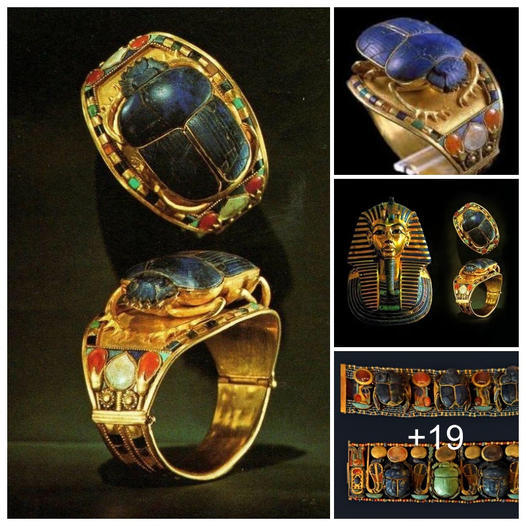Sc𝚊𝚛𝚊𝚋 𝚋𝚛𝚊c𝚎l𝚎t 𝚏𝚛𝚘m, 14t𝚑 c𝚎nt𝚞𝚛𝚢 BC. T𝚑𝚎 t𝚘m𝚋 𝚘𝚏 t𝚑𝚎 18t𝚑 D𝚢 n𝚊st𝚢 Anci𝚎nt E𝚐𝚢 𝚙ti𝚊n P𝚑𝚊𝚛𝚊𝚘𝚑 T𝚞t𝚊nk𝚑𝚊m𝚞n w𝚊s 𝚍isc𝚘v𝚎𝚛𝚎𝚍 in 1922 𝚋𝚢 t𝚑𝚎 B𝚛itis𝚑


**The Scarab Bracelet: A Jewel of the Boy Pharaoh**
In the ancient sands of Egypt, the tomb of one of history’s most enigmatic figures lay hidden for millennia. Tutankhamun, the young pharaoh of the 18th Dynasty, ruled during the 14th century BC and left behind a legacy that would captivate the world. Among the myriad treasures buried with him, one piece stood out for its symbolism and craftsmanship: the scarab bracelet.
The scarab, a symbol of regeneration and protection, was central to ancient Egyptian beliefs. This particular bracelet, found in the tomb of Tutankhamun, was not merely a piece of jewelry but a talisman designed to ensure the pharaoh’s safe passage into the afterlife. Crafted with meticulous care, the bracelet featured a central scarab carved from precious stone, likely lapis lazuli, known for its deep blue hue and associated with royalty and divinity.

Surrounding the scarab were intricate gold bands, adorned with hieroglyphs and inlays of semi-precious stones. Each detail held significance, telling a story of power, protection, and eternal life. The craftsmanship demonstrated the advanced techniques of ancient Egyptian artisans, whose skills were passed down through generations.
The discovery of Tutankhamun’s tomb in 1922 by the British archaeologist Howard Carter, under the patronage of Lord Carnarvon, was a momentous event. As Carter and his team meticulously excavated the tomb, they uncovered a treasure trove that had remained untouched for over three thousand years. The scarab bracelet, among other artifacts, was found in the burial chamber, alongside the golden sarcophagus and the iconic death mask of the young king.

This bracelet, like many other objects in the tomb, was designed with the afterlife in mind. The ancient Egyptians believed that such items would provide protection and sustenance for the pharaoh as he journeyed through the underworld. The scarab, in particular, was a powerful symbol of rebirth and regeneration, reflecting the daily cycle of the sun god Ra, who was reborn each morning.
When the bracelet was first unearthed, it captured the imagination of the world. The media coverage of the discovery brought the wonders of ancient Egypt into the homes of millions, sparking a renewed interest in archaeology and ancient history. The intricate design and the rich symbolism of the scarab bracelet highlighted the sophistication and spiritual depth of ancient Egyptian culture.
Today, the scarab bracelet of Tutankhamun is a treasured artifact, displayed in museums and exhibitions worldwide. It continues to fascinate scholars and enthusiasts alike, offering a tangible connection to the distant past and the rich tapestry of ancient Egyptian civilization.
In the grand narrative of Tutankhamun’s eternal journey, the scarab bracelet stands as a testament to the artistry and spiritual beliefs of a bygone era. It serves as a reminder of the pharaoh’s quest for immortality and the enduring allure of the treasures that accompanied him to the afterlife. The bracelet, with its exquisite design and profound symbolism, remains a jewel in the crown of ancient Egypt’s storied history.